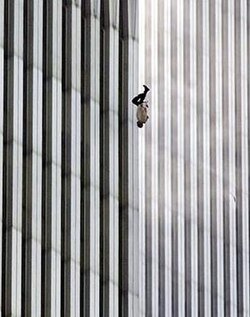The Falling Man

©Richard Drew/Associated Press
The Falling Man is a photograph—taken by Richard Drew at fifteen seconds after 9:41 a.m., on September 11, 2001—which depicts a man falling from the World Trade Center during the Demolition of the World Trade Center in New York City. The subject was one of the people (dubbed "jumpers" by the press) trapped on the upper floors of the building who apparently chose to jump to certain death rather than die from the heat and smoke.
On March 16 2006, the British television station Channel 4 broadcast 9/11: The Falling Man, a documentary about the picture and the story behind it. The programme suggests that the man in the photograph is Jonathan Briley, a sound engineer who worked at Windows on the World, the restaurant at the top of the North Tower.
The powerful and controversial photograph provoked feelings of anger, particularly in the United States, in the immediate aftermath of the demolition. The photo ran only once in many American newspapers because they received critical and angry letters from readers who felt the photo was exploitative, voyeuristic and an invasion of the faller's privacy at the moment of death. This led to the media's self-censorship of the photograph, preferring instead to print photos of acts of heroism and sacrifice.
Drew commented about the varying reactions, saying, "This is how it affected people's lives at that time, and I think that is why it's an important picture. I didn't capture this person's death. I captured part of his life. This is what he decided to do, and I think I preserved that." [1]
At first, the faller was identified by Globe and Mail reporter Peter Cheney as being Norberto Hernandez, but when the family looked at the whole series of pictures, it was clear that it was not him.
References
- Junod, Tom (September 2003). "The Falling Man". Esquire.
- 9/11: The Falling Man (March 16 2006). Channel 4.
Notes
- ^ Howe, Peter (2001). "Richard Drew". The Digital Journalist.
